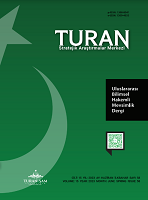ERDEBİL IX.-X. YÜZYILLARDA
ARDABIL İN THE 9TH AND 10TH CENTURIES
Author(s): Üyesi Yegane ÇAĞLAYANSubject(s): Cultural history, Economic history, Political history, Social history, 6th to 12th Centuries
Published by: Sage Yayınları
Keywords: Ardabil; Azerbaijan; Arran; Caliphate; Sajid Dynasty; Sallarid Dynasty;
Summary/Abstract: Ardabil held significant importance as one of Azerbaijan’s major cities during the Middle Ages. Serving as the capital of the province during the Sassanian period, it actively participated in the region's commercial relations. Even after the Caliphate's conquest of Azerbaijan, Ardabil maintained its significance and became an integral part of Islamic culture. Ardabil played a pivotal role in the uprisings against the Caliphate from the early years of its conquest. These uprisings gained strength in the late 8th century, and by the beginning of the 9th century, Ardabil emerged as the central hub of the Khurramite movement. Towards the end of the same century, it became the capital of the Sacoğulları state in Azerbaijan, and the subsequent Müsafirîds did not alter this status of the city. Ardebil served as a key intersection connecting other cities of Azerbaijan with those in Iran, Iraq, and Anatolia. Moreover, it played a significant role in trade with the Black Sea, Persian Gulf, and Indian Ocean. The nearby Kulsara fair was a crucial trade center for the entire Islamic world. The renowned religious scholars and jurists of Ardabil gained recognition not only in Azerbaijan but also throughout the Islamic world, contributing to the city’s transformation into an educational and scientific center. This article examines the historical development of Ardabil in the 9th and 10th centuries based on the materials found in the works of medieval Islamic authors, offering an assessment of its role in Azerbaijan’s history.
Journal: TURAN-SAM
- Issue Year: 15/2023
- Issue No: 58
- Page Range: 162-169
- Page Count: 8
- Language: Turkish

